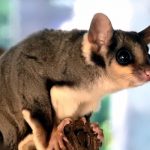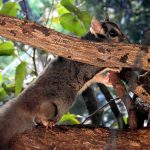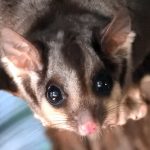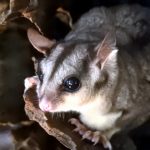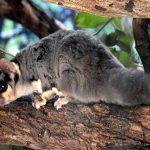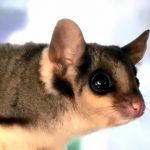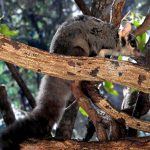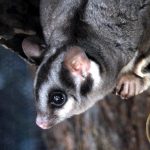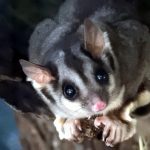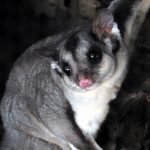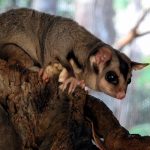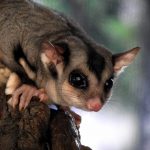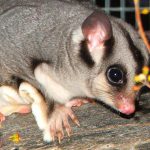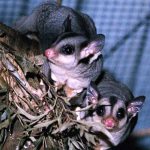SQUIRREL GLIDER
Petaurus norfolcensis
The Nocturnal Ballet of the Squirrel Glider
Beneath the silver glow of the moon, Australia’s dry sclerophyll forests and woodlands transform into a stage for one of nature’s most enchanting performers—the Squirrel Glider. As the world quietens, this agile marsupial begins its nightly journey, gliding from tree to tree in a graceful, near-silent ballet. For those fortunate enough to observe, the experience is nothing short of magical—a rare glimpse into the delicate balance of the wild.
Meeting the Squirrel Glider
| Attribute | Squirrel Glider | Sugar Glider |
|---|---|---|
| Head & Body Length | 180–230 mm | 160–210 mm |
| Tail Length | 220–300 mm (often longer than body) | 170–210 mm |
| Distinctive Features | Pointed face, long narrow ears, bushy tail | Rounder face, shorter ears, less bushy tail |
At first glance, Squirrel Gliders and their smaller cousins, the Sugar Gliders, appear almost identical. Yet, with a closer look, the Squirrel Glider reveals its distinctive elegance: a more tapered face, longer and narrower ears, and a luxuriously bushy tail that sweeps behind it like a plume.
Life in the Treetops
Diet and Feeding
The Squirrel Glider’s menu is a varied feast:
- Gum from Acacia and select Eucalyptus trees
- Invertebrates such as insects and spiders
- Exudates (sap and honeydew) from trees and insects
As you move through the forest on a crisp night, listen for the subtle sounds: the gentle crackle of bark, the faint rustle of leaves, and the soft tapping as a glider seeks its meal.
Reproduction and Family Life
Every August, the cycle of life renews:
- Breeding: Each female produces two tiny young.
- Pouch Development: The young spend 70 days nestled in their mother’s pouch, shielded by warmth and safety.
- Nest Life: They then spend about 30 days in a communal nest—a hollow in a tree, lined with fragrant, dry leaves.
- First Forays: Soon after, the young venture out with their mother, learning to glide and forage beneath the stars.
The Art of Gliding
Imagine standing quietly under the canopy as a Squirrel Glider leaps from a high branch. With powerful hind legs, it launches itself into the air, stretching out membranes of skin from its fifth finger down to its first toe. These gliding membranes, called patagium, catch the night air, allowing the glider to soar up to 50 metres between trees. Its bushy tail acts as a rudder, steering with minute adjustments. The landing is soft—a gentle touch on rough bark, almost undetectable.
Challenges: Predators and Peril
Natural Predators:
- Owls: Their silent flight makes them formidable hunters in the dark.
- Kookaburras: Keen-eyed and patient.
- Goannas: Climbing reptiles adept at raiding nests.
Human-induced Threats:
- Habitat Loss: Clearing of forests reduces nesting sites and food sources.
- Predation by Cats: Both domestic and feral cats are significant threats, especially at night.
A Simple Step for Cat Owners:
- Keep cats indoors during the night.
- If outside, ensure cats wear collars with at least three bells to reduce their hunting success.
Conservation Status: A Patchwork of Risk
| State/Territory | Conservation Status |
|---|---|
| New South Wales | Vulnerable |
| Victoria | Threatened |
| South Australia | Endangered |
| Queensland | Common |
This variation underscores the importance of local conservation efforts and habitat protection. Each state holds a piece of the Squirrel Glider’s future in its hands.
A Call to Cherish and Protect
To witness a Squirrel Glider in the wild is to be reminded of nature’s quiet wonders and the intricate web of life that sustains them. The scent of eucalyptus in the air, the rough texture of ancient bark under your hand, and the soft rustle of wings overhead—these moments connect us to something greater than ourselves.
How You Can Help:
- Support and respect habitat preservation initiatives.
- Plant native trees and shrubs to provide food and nesting sites.
- Advocate for responsible pet ownership and wildlife-friendly practices.
The story of the Squirrel Glider is a tapestry woven with beauty, resilience, and vulnerability. By learning about and safeguarding these remarkable animals, we not only protect a species but also preserve the rich diversity and wonder that define Australia’s natural heritage.
Let us ensure that future generations can look up into a moonlit forest and marvel at the silent flight of the Squirrel Glider—a living symbol of the wild heart of Australia.

